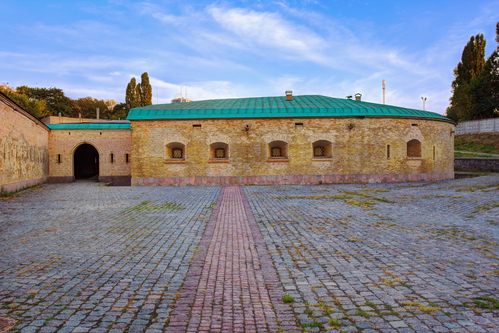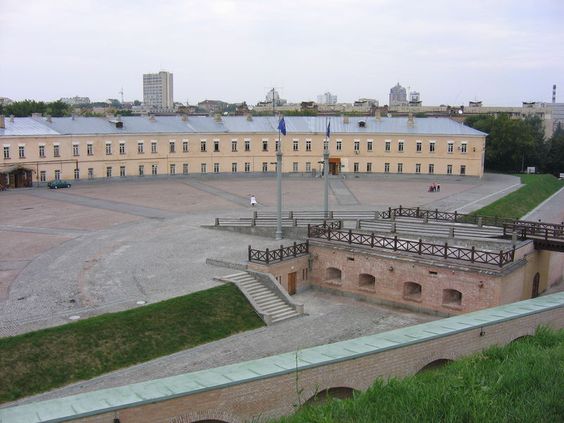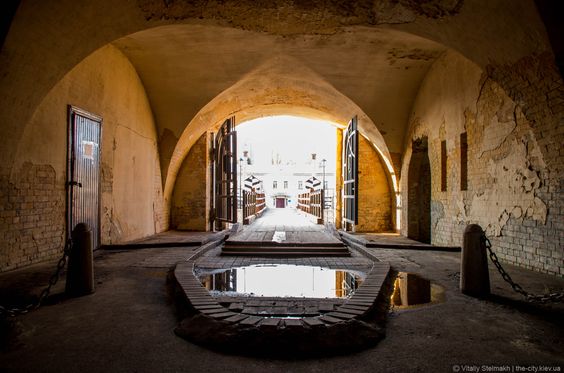Kosoy Kaponir (Oblique caponier) is only a part of a huge Kyiv fortress, which is the largest in Europe and second largest in the world earthen fortress. The construction of Kyiv fortress began in 1706 by the order of Peter the Great. In that time, the Russian Empire was weakened by the war with Sweden, and there was a danger for Kyiv to be occupied by Turkey or Crimean Khanate. Therefore, the main purpose of the newly built fortress was to enforce Kyiv military positions. Kyiv fortress includes fortifications in Kyiv-Pecherska Lavra, territory of the National museum of the Second World War, Arsenal plant and many other objects mostly located in Pechersk district.

Read: Kamyanets-Podilsky Fortress
Kosoy Kaponir was built in 1844. It is a defensive construction of Hospital fortification in Kyiv fortress system. Kosoy Kaponir is a semi-underground construction with thick walls made of stone and brick. Firing ports and embrasures for gunnery are embedded into the walls. This is the only place in Europe with fully restored complicated system of 10-15-meter high earth walls and deep fosses. Earth walls were cut through by patterns – bricked tunnels with length up to 40 meters, closed by lattices from both sides. Above-ground part of Kosoy Kaponir projects to Cherepanova mountain. Kosoy Kaponir building is located at the angle to the fortress earth wall in order to ease the process of artillery crossfire, and that is the reason why it is called “kosoy” (oblique). Multi-level defense system of fortress left no chance for its occupation. Kosoy Kaponir was surrounded by fosse. The only way to enter the building was through the suspended gate. If enemies smashed the first defense level, they were immediately attacked from the other fortification. In such way, the fortress was considered as unassailable.

First, Kosoy Kaponir was used for weapons and artillery ammunition storage. In the beginning of 1860s, the fortress was turned into a political prison. Many prisoners, who were mostly revolutionists, were executed here by a firing squad. Participants of January Uprising against the Russian Empire (1863-1864) became the first prisoners of the fortress. Participants of the First Russian Revolution (1905-1907), such as Boris Zhadanovsky, were also imprisoned in Kosoy Kaponir. Later, the fortress became a dungeon for Dmitry Bogrov, the Russian anarchist and the killer of Piotr Stolypin, the famous Russian statesperson. Kosoy Kaponir was called “Kyiv Shlisselburg” for its tough conditions. In Soviet times, Kyiv brig functioned on the territory of Kosoy Kaponir. The brig was also known for hard treatment of imprisoners. 
Read: Akkerman Fortress near Odesa
Today the territory of Kosoy Kaponir include two museums, dedicated to history of this fortification. The first museum is located underground. The room is kept in the same state as it was in prison times. The museum exposition consists of old utensils, weapons, uniform, personal possessions of imprisoners. The second museum presents military clothing of different periods and historical documents, related to the history of Kyiv and Kosoy Kaponir. The museums working hours are 10:00-17:00. Monday is the day off.
One of the fortification parts, caponier #2 was restored few years ago. During restoration process, it was found out that the large domical hall of the fortification had very good acoustics. Since then, chamber literature and musical evenings regularly take place here.
Expand your history knowledge, visiting Kosoy Kaponir fortress in Kyiv.
Address: 24а, Hospitalna street
Photo source: depositphotos.com, shutterstock.com, pinterest.com. All photos belong to their rightful owners.
Kosoy Kaponir Fortress in Kyiv
Many travelers and even native Kyiv dwellers feel surprised when they hear that a large fortress is located in the very center of Ukrainian capital. However, it is true, and those who are interested can find this historical place, hidden in the labyrinth of Pechersk district streets. Kosoy Kaponir fortress, situated near Kyiv military hospital, impresses visitors with its significant size and spectacular views. Let us consider the history of this unique location.







